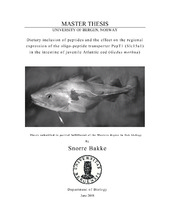| dc.description.abstract | PepT1 (Peptide Transporter 1, SLC15A1) is a proton-coupled peptide transporter responsible for uptake of short peptides and peptide-like drugs from the intestinal lumen into enterocytes. A PepT1-type transporter has recently been sequenced for Atlantic cod and found to be expressed along the whole post-gastric intestine including pyloric caeca. In the present thesis the effect of dietary inclusion of peptides and amino acids on expression of PepT1 mRNA in different regions of juvenile Atlantic cod intestine was investigated. Five groups of cod weighing 10-15 grams were fed for 46 days with a diet containing approximately 42% crude protein, either as fishmeal (FM diet) or 30 % of the fish meal substituted by either whole fish hydrolysate (FH diet), retenate after ultra filtration of fish hydrolysate (UFR diet), retenate after nano filtration of fish hydrolysate (NFR diet) or a mix of free amino acids (FAA diet). After 14 days (T1) and at the end of the experiment (46 days; T3), three fish were sampled from each group and the intestine divided into five segments, namely pyloric caeca (S1) and the remainder of the intestine from the pyloric caeca to the anus divided into four equally long segments (S2 to S5). Total RNA isolated from each segment was subjected to a two-step quantitative RT-PCR using SYBR green and Atlantic cod elongation factor 1 alpha as reference gene. For all diets PepT1 was found to be expressed in all segments, suggesting that for juvenile Atlantic cod the whole intestine is involved in peptide absorption. The different groups of fish showed a similar PepT1 mRNA expression in all segments, but differences in regional expression were found. At T3 the regional expression profile showed statistical differences in PepT1 expression between segments in the FAA and UFR fed fish (diets included amino acids or larger sized peptides). Both groups had a higher expression in S2 and S3 (mid intestine) then pyloric caeca (S1) and S5. A similar trend was also observed for the UFR at T1, while the FAA fed fish had a low and stable expression in all segments at T1. No significant differences in PepT1 expression were found between segments in the FM, FH or the NFR fed group for any time. These results suggest that for diets where 30% of the fish meal has been replaced by fish hydrolysate containing short peptides (FH and NFR) the involvement of the pyloric caeca in peptide absorption is similar to the remainder of the intestine, while diets with no or low amounts of short chained peptides included (FAA and UFR) have a lower involvement of pyloric caeca in peptide absorption compared to mid intestine. A general higher expression of PepT1 was found at T3 then at T1 in all segments except S4, but no interaction between time and diet was found, indicating that some developmental or growth related changes in PepT1 expression occurs during this life stage of Atlantic cod. These results suggest that dietary peptides of various chain lengths as well as free amino acids affect the regional expression of PepT1 mRNA in the intestine of juvenile Atlantic cod. The signaling pathways responsible for PepT1 regulation still remains to be described. | en_US |
